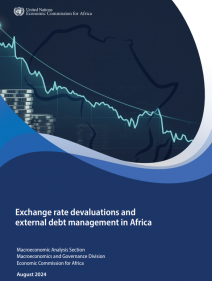The use of exchange rate devaluation has recently re-emerged as a stabilization tool to correct macroeconomic imbalances in developing countries, as was the case under the structural adjustment programmes during the debt crisis of the 1980s. There has been increased use of active exchange rate policies to enhance economic activity and safeguard lives and livelihoods from the consequences of recent economic crises. At the same time, public debt has also re-emerged as one of the issues at the centre of economic and political debate in Africa, as governments have resumed debt accumulation to invest in infrastructure and social spending as part of efforts to recover from the effects of recent economic shocks. Despite the current prominence of debt management and exchange rate depreciation issues, there have been very few recent empirical studies looking at the relationship between these economic fundamentals. The main objective of the present paper is therefore to examine the extent to which exchange rate depreciation affects external debt in Africa, in both the short and the long run, taking into consideration countries’ exchange rate regimes and natural resource intensity. The study applies the panel cointegration method by estimating the autoregressive distributed lag model to allow for the assessment of both the short- and long-term effects of exchange rate developments on external debt. The results indicate that in countries with relatively fixed exchange rate regimes, devaluation is more likely to result in a reduction of the external debt burden, while in countries with flexible exchange rate regimes, devaluation is more likely to enhance the impact of exports on external debt reduction. To some extent, the results suggest that flexible exchange rates may not be operating at their optimal levels to ensure a significant negative impact of exchange rate devaluation on external debt.
Share this:
Release Date:
4 February, 2025
© United Nations Economic Commission for Africa

